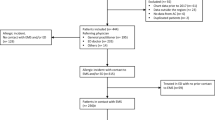Summary
In 1981 generalized anaphylaxis was registered on 166 occasions in Dutch general and academic hospitals. Clinical details of 120 of those patients revealed that in 107 anaphylaxis was either probable (n=90) or possible (n=17), whereas in 13 cases some other reaction than anaphylaxis had occurred. The series of confirmed cases contained 46 men and 61 women, with mean ages of 47 y and 48 y, respectively.
There was a complete recovery in 102 patients and two patients died. Hypotension was present in 79 cases (74%), dyspnoea in 34 cases (32%) and a skin reaction, mainly urticaria, erythema or angioedema, was mentioned in 62 cases (58%). Most cases of anaphylaxis were drug-induced (76%), the main causes being the analgesic glafenine and contrast media. Glafenine was mentioned as the cause in 36% of all admissions for drug-induced anaphylaxis. Only 3.7% of cases had been reported to the voluntary reporting scheme of the Netherlands Centre for Monitoring of Adverse Reactions to Drugs.
On the basis of reimbursement data, the risk of developing severe anaphylaxis to glafenine was estimated at 11.7–19.3-fold relative to indomethacin, and 13.4–20.2-fold relative to oral penicillins.
Similar content being viewed by others
References
Wasserman SI, Marquardt DL (1988) Anaphylaxis. In: Allergy. Principles and practice. Middleton E, Reed CE, Ellis EF, Adkinson NF, Yunginger JW (ed) pp 1365–1376
Miettinen OS (1976) Estimability and estimation in case-referent studies. Am J Epidemiol 103: 226–235
Meyboom RHB (1976) Anafylaxie na het gebruik van glafenine. Ned Tijdschr Geneesk 120: 926–927
Maesen F, Mol JM, Brombacher PJ, Bok EJ, Voorden JMJ, Van de Vijgen JH (1976) Anafylactische shock na gebruik van glafenine (Glifanan). Ned Tijdschr Geneesk 120: 926–927
Meyboom RHB (1979) Problemen met glafenine. Geneesmid-delenbull 13: 23–26
Gaultier M, Bismuth C, Efthymiou ML, Morel-Maroger L, Romion A (1972) Nouv Presse Méd 1: 3125–3128
Barral C, Faivre M (1975) Accidents anaphylactiques imputés à la glafenine. Cinq cas. Nouv Presse Méd 4: 2797–2798
Michaud JL, Doublet L (1976) Choc induit par la glafénine. Six nouveau cas. Nouv Presse Méd 5: 716
Cheymol G, Biour M, Bruneel M, Albengres E, Hamel JD (1985) Bilan d'un enquête nationale prospective sur les effects indésirables de la glafénine, de l'antrafénine et de la floctafénine. Therapie 40: 45–50
Saxon A, Beall GN, Rohr AS, Adelman DC (1978) Immediate hypersensitivity reactions to beta-lactam antibiotics. Ann Intern Med 107: 204–215
Weiss ME, Adkinson NF (1988) Immediate hypersensitivity reactions to penicillin and related antibiotics. Clin Allergy 18: 515–540
Author information
Authors and Affiliations
Rights and permissions
About this article
Cite this article
Stricker, B.H., de Groot, R.R.M. & Wilson, J.H.P. Glafenine-associated anaphylaxis as a cause of hospital admission in the Netherlands. Eur J Clin Pharmacol 40, 367–371 (1991). https://doi.org/10.1007/BF00265845
Received:
Accepted:
Issue Date:
DOI: https://doi.org/10.1007/BF00265845




